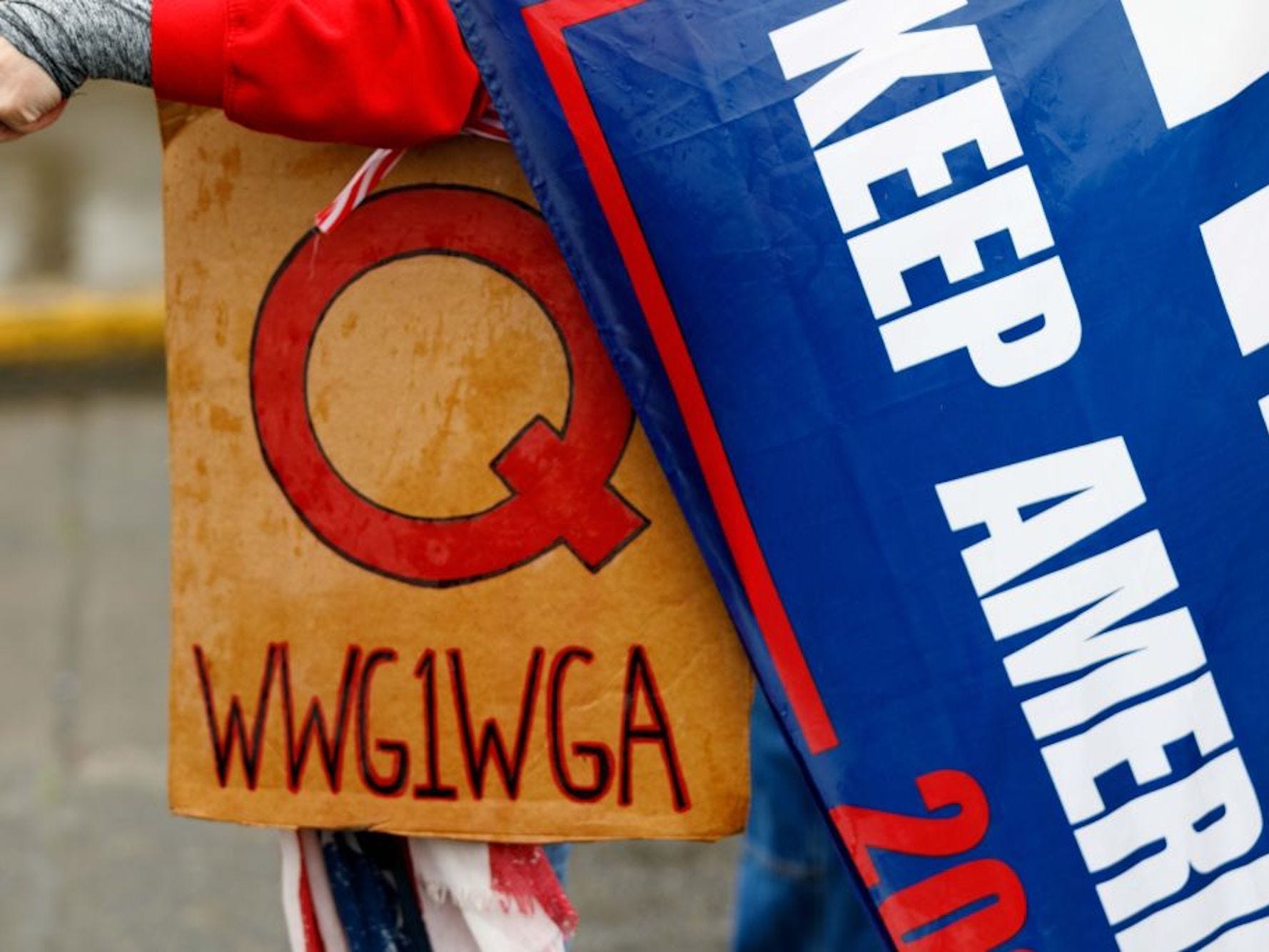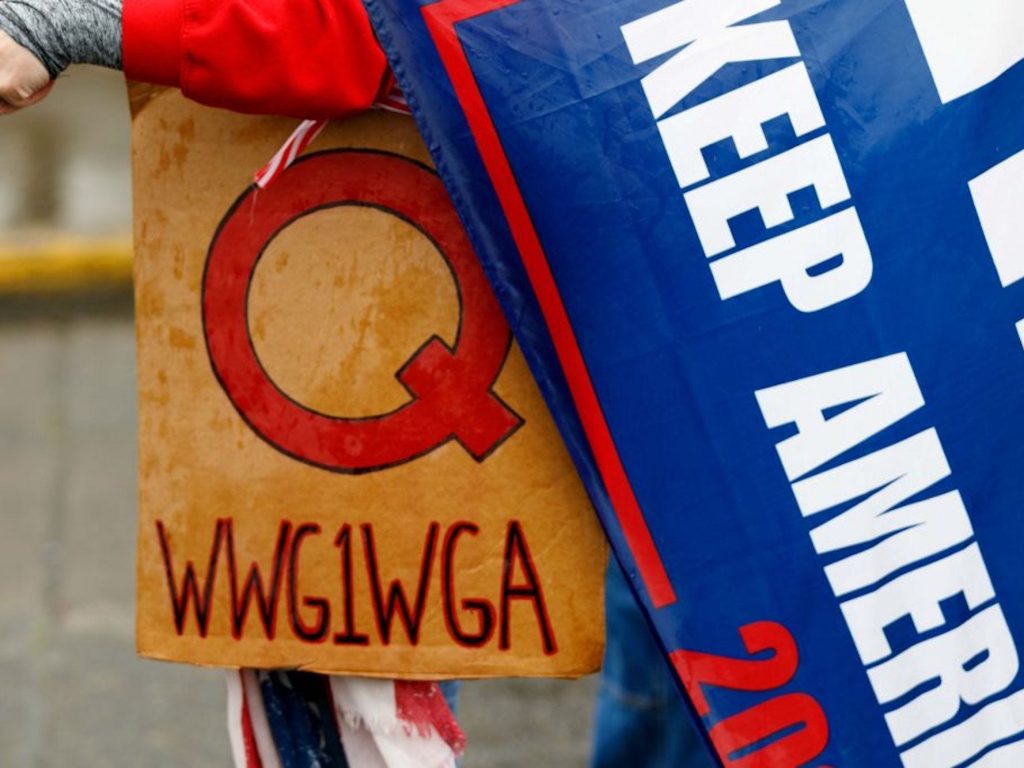
John Rudoff/Anadolu Agency via Getty Images
- A report this week said QAnon catchphrases are disappearing from social media after a tech crackdown.
- Analysts say Q's believers are still a threat, as they evade surveillance by avoiding keywords.
- Q's followers could also be finding new online rabbit holes to spread conspiracy theories.
- See more stories on Insider's business page.
Following a crackdown by tech giants on QAnon, new research released this week says that "chatter" related to the far-right conspiracy theory-fueled movement has decreased significantly. But analysts say that while QAnon-related catchphrases may be slowly disappearing from mainstream social media platforms, ardent followers of Q are finding ways to evade detection and discovering new rabbit holes to spread their
QAnon is a baseless far-right conspiracy theory that claims former President Donald Trump is secretly fighting a "deep state" cabal of satanic pedophiles and cannibals. The movement also claims that "Q," the shadowy figure at the center of it, has top-level access to confidential information, much of which paints a positive picture of Trump.
The movement helped perpetuate voter-fraud claims regarding the 2020 presidential election. And more recently, numerous participants in the Jan. 6 Capitol riot said their actions were inspired and influenced by their belief in Q.
A study published this week by the Atlantic Council's Digital Forensic Research Lab analyzed more than 40 million instances where QAnon keywords appeared on social media. These included closer looks at the number of times 13 phrases appeared, including the rallying cry "WWG1WGA," (an acronym for "where we go one, we go all") "the storm," "great awakening," and "trust the plan."
Jared Holt and Max Rizzuto, who are both researchers at the think tank, found that the number of times QAnon catchphrases were mentioned surged at several points – during the Black Lives Matter protests, before the 2020 presidential election, and before the Capitol attack. But mentions of these Q-catchphrases nosedived when tech stepped in with content moderating measures and has dulled to what they call a "low murmur" after mass bans of some 70,000 QAnon-related Twitter accounts and a crackdown on Facebook groups affiliated to the movement.
New rabbit holes for QAnon followers to spread conspiracy theories

Rick Loomis/Getty Images
But researchers cautioned that a dip in chatter does not mean that the QAnon movement has not vanished altogether. They also noted that the anonymous "Q" account instructed followers last year to "deploy camouflage" and to purposefully avoid mentioning the account to evade social media clampdowns.
Jason Blazakis, a senior research fellow at the Soufan Center and professor at the Middlebury Institute, told Insider QAnon believers remain a threat to international peace and stability.
He theorized that this dip in chatter means that there may be a "combination" of things happening. Firstly, that some QAnon followers could be abandoning the movement because Q's predictions have been proven to be bogus too many times. Secondly, the movement's remaining believers may be doing one of two things: forgoing old hashtags and using other modes to communicate with each other, or simply moving to fringe platforms and finding lesser-known rabbit holes online to spread their conspiracy theories.
"I, for one, remain worried about QAnon followers. Those who still believe are the most rabid fomenters of dangerous conspiracy theories. And, if they are moving to other platforms and using coded language in ways that have yet to be identified, that presents a challenge for those who are responsible for detecting problematic behavior in the online and offline space," Blazakis told Insider.
Earlier this month, Mashable reported that followers were substituting words and incorporating fresh code phrases in their posts to dodge social media tracking. This could be done by calling QAnon "cue anon," or referring to the mysterious Q by the number "17," because Q is the 17th letter of the alphabet. The AP reported in October last year that innocuous slogans like "Save the Children" were also co-opted and used to talk about Q without mentioning the alphabet.
Holt and Rizzuto added that some followers have created a "neo-QAnon" instead, a cluster of movements that promote the same claims, without the "hallmark linguistic stylings" of the original QAnon movement. Speaking to Forbes, Holt posited as well that new QAnon communities could have formed to talk about fresh topics.
"A lot of QAnon communities we're aware of have pivoted on to other topics, like vaccine conspiracies and claims about the Biden Administration," Holt told Forbes.
"In that way, they're plugging into broader misinformation and disinformation ecosystems online, which tend to reach more people," he added.
Blazakis added that terrorist groups have long adapted to the tactics used by law enforcement, and cautioned that law enforcement and intelligence agencies must adapt to possible evolutions in the way QAnon believers communicate. How this can be done, Blazakis said, is by having law enforcement agencies partner with tech experts who track QAnon.
"Too many people from all over the globe remain intrigued by the core narrative of QAnon, that there is some Satan-worshipping secret cabal of global elites who are engaged in pedophilia," he said, adding that he does not believe we have seen the last of QAnon-inspired violence.
"There very well could be QAnon spin-offs that gain the approval of a large number of followers, but that doesn't render QAnon irrelevant," he said. "It may just have new contenders that vie for the attention of conspiracy theorists."
